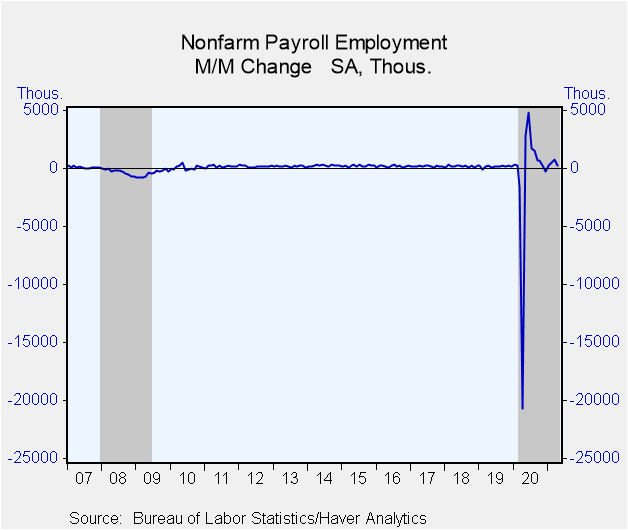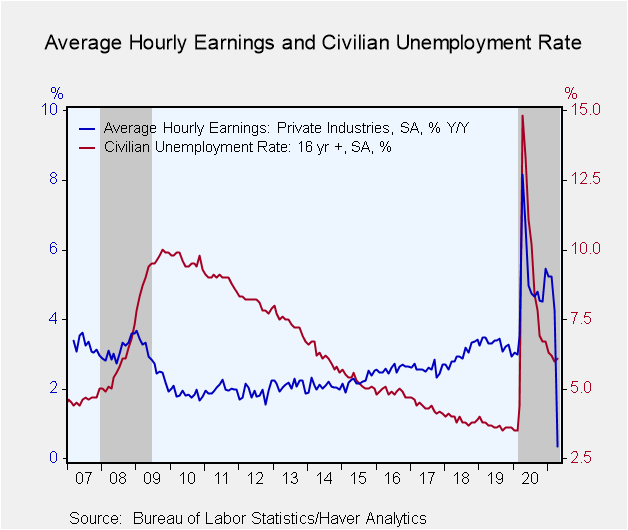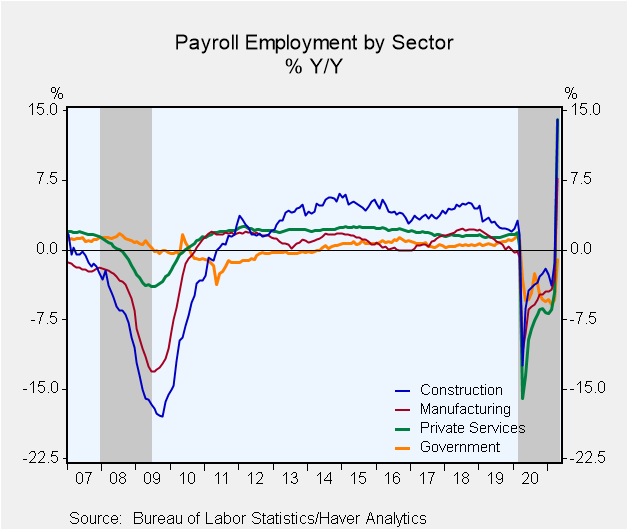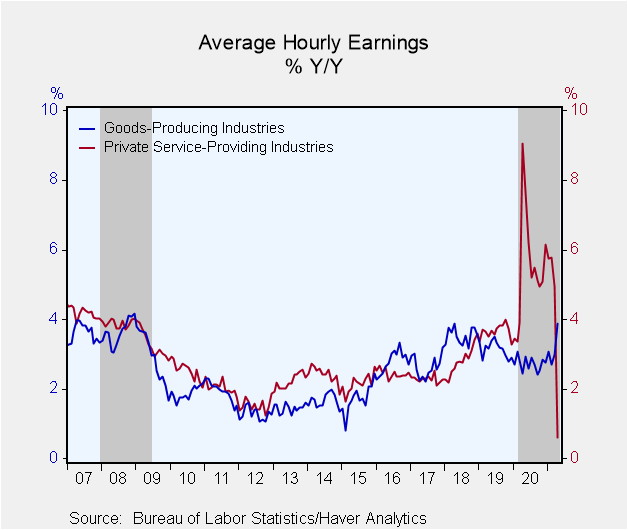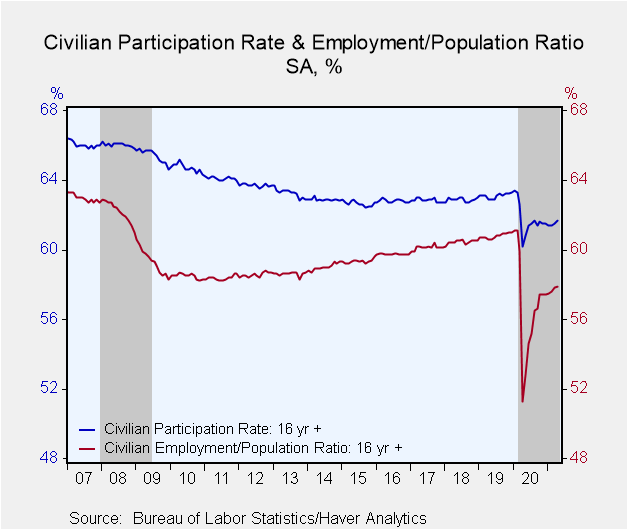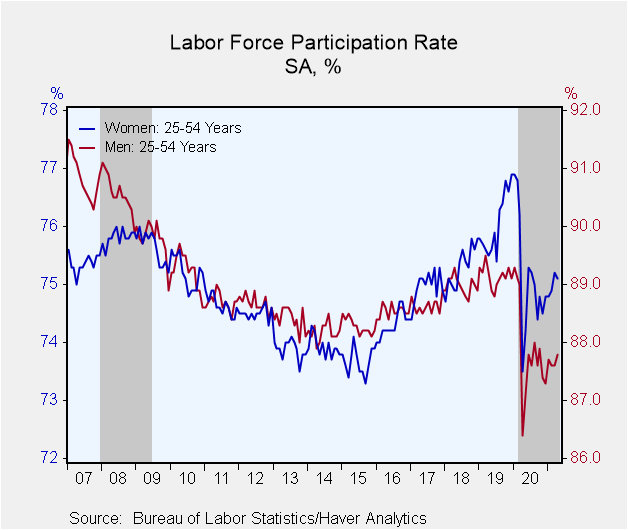 Global| May 07 2021
Global| May 07 2021U.S. Payrolls Greatly Disappoint in April; Earnings Strengthen, While Jobless Rate Edges Higher
by:Tom Moeller
|in:Economy in Brief
Summary
• Weakness in hiring is broad-based. • Average hourly earnings rebound, reversing March decline. • Unemployment rate edges up from twelve-month low. Strength in the labor market waned following the initial lift from business re- [...]
• Weakness in hiring is broad-based.
• Average hourly earnings rebound, reversing March decline.
• Unemployment rate edges up from twelve-month low.
Strength in the labor market waned following the initial lift from business re-openings and COVID-19 vaccines. Nonfarm payroll employment increased 266,000 (10.9% y/y) during April. A 950,000 rise had been expected in the Action Economics Forecast Survey. It was the weakest increase in three months. The unexpectedly smaller gain was accompanied by a downward revision to the March increase to 770,000 from 916,000. February's gain was revised to 536,000 from 468,000.
Average hourly earnings strengthened 0.7% last month (0.3% y/y) after easing an unrevised 0.1% in March. It was the largest increase since December and compared to expectations for stability.
The unemployment rate rose to 6.1% in April from 6.0% in March, compared to expectations for a drop to 5.8%. The labor force rose 430,000 after a 347,000 gain, as workers were encouraged to rejoin the labor market with improving economic conditions. At the same time, employment in the household survey grew by a smaller 328,000 after rising 609,000. The overall unemployment rate, including those who were marginally attached or working part-time for economic reasons, fell to 10.4% from 10.7%. It was the lowest level since March of last year.
From the payroll survey, the 266,000 increase in jobs included an 18,000 decline (+7.7% y/y) in factory sector hiring. Construction payrolls held steady (14.3% y/y). Mining & logging employment rose 2.0% (-0.7% y/y).
Private service sector payrolls grew 234,000 (14.0% y/y). Performance amongst industries was mixed. A 331,000 increase (61.9% y/y) in leisure & hospitality employment accompanied an 18,500 rise (8.1% y/y) in health care & social assistance. Financial services jobs rose 19,000 (2.5% y/y). Information sector employment edged 1,000 higher (2.2% y/y). Elsewhere, declines were widespread. Trade, transportation & utilities jobs weakened 81,000 (+10.4% y/y) including a 15,300 drop (+14.7% y/y) in retail trade. Professional & business services jobs fell 79,000 (+8.7% y/y) and reversed March's increase. Within that total, temporary help jobs declined 111,400 (+37.0% y/y). The number of education & health services jobs eased 1,000 (+7.7% y/y) after increasing 104,000 in March.
Government sector employment rose 48,000 last month (-1.0% y/y) following a 62,000 March rise. Local government employment rose 32,000 (-1.1% y/y) while state governments added 7,000 jobs (-1.9% y/y). Federal government hiring improved 9,000 (0.7% y/y).
Average hourly earnings rose 0.7% on the strength of a 2.1% jump (1.6% y/y) in mining & logging and a 1.6% rise (-0.7 y/y) in leisure hospitality earnings. Information services earnings also rose 1.6% (2.0% y/y. Construction sector earnings improved 1.0% (3.8% y/y) while factory sector pay strengthened 0.6% (0.1% y/y). Elsewhere in the service sector, professional business service earnings improved 0.4% (0.6% y/y) and financial services pay rose 0.2% and strengthened 6.6% y/y.
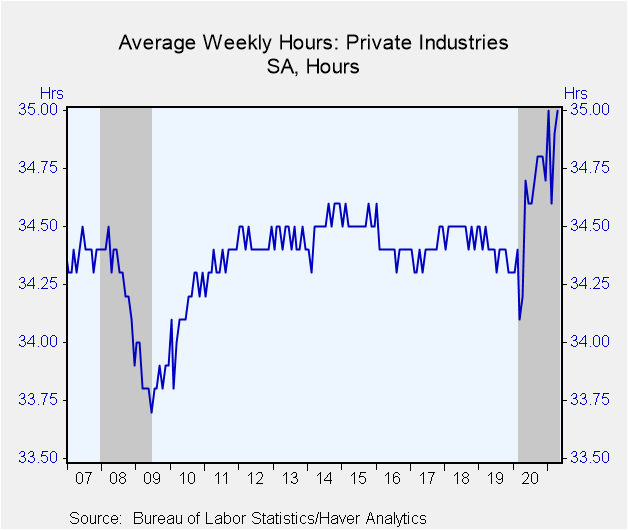 The length of the workweek in the private sector lengthened
to 35.0 hours, returning to its January record. (The series dates back to March
2006.) For production & nonsupervisory workers, the workweek held steady at
a roughly 20-year high of 34.4 hours. Mining & logging hours eased to 45.2
while factory hours held steady at 40.5. Construction sector hours fell to
39.1. In the private service sector, hours edged up to a record 33.9 as trade,
transportation and utilities hours grew to 39.5. Information sector hours
rose to 37.4 and professional & business service sector hours grew to 37.0.
Leisure & hospitality hours rose to 26.7.
The length of the workweek in the private sector lengthened
to 35.0 hours, returning to its January record. (The series dates back to March
2006.) For production & nonsupervisory workers, the workweek held steady at
a roughly 20-year high of 34.4 hours. Mining & logging hours eased to 45.2
while factory hours held steady at 40.5. Construction sector hours fell to
39.1. In the private service sector, hours edged up to a record 33.9 as trade,
transportation and utilities hours grew to 39.5. Information sector hours
rose to 37.4 and professional & business service sector hours grew to 37.0.
Leisure & hospitality hours rose to 26.7.
From the household employment survey, the 6.1% unemployment rate in April occurred as the labor force participation rate edged up to 61.7%, though it remained below the 63.4% high in January of last year. The teenage participation rate rose to 37.4% but for individuals aged 20-24, it held steady at 70.3%. For workers aged 25-54, the rate held at 81.3%, but remained below the January 2020 high of 83.0%. For men aged 25-54, the rate rose to 87.8% and remained down from the high of 89.5% in March of 2019. For women of that age, the rate eased to 75.1%, remaining below the record high of 76.9% in January of last year. For workers aged 55 & over, the participation rate rose to 38.3%, still below the July 2019 high of 40.5 hours.
The employment/population ratio for all workers rose to 57.9% in April, staying well below the February 2020 high of 61.1%. The number of persons who teleworked or worked at home for pay rose 13.4% y/y to 151.2 million. Of those, 27.6 million did so because of the coronavirus.
The teenage unemployment rate fell to 12.3% from 13.0% in March and remained below the record 32.1% last April. The rate for workers aged 20-24 rose slightly to 10.5%. For workers aged 25-54, the rate held steady at 5.5%, down from the 12.8% last April's high. For those over 55, the jobless rate rose sharply to 5.0% but remained well below its record 13.6% high in April '20.
By educational attainment, the rate of unemployment of workers without a high school diploma rose sharply to 9.3% from 8.2%, still below the 21.0% rate one year ago. High school graduates without any college were 6.9% unemployed last month, down from last April's high of 17.3%. Those with some college but no degree were 5.8% unemployed, down sharply from the 15.0% last April's peak. College graduates saw their unemployment rate ease to 3.5% last month, still significantly higher than their 1.9% low in February of last year.
The employment & earnings data are collected from surveys taken each month during the week containing the 12th of the month. The labor market data are contained in Haver's USECON database. Detailed figures are in the EMPL and LABOR databases. The expectations figures are in the AS1REPNA database.
| Employment (SA, M/M Change, 000s) | Apr | Mar | Feb | Apr Y/Y | 2020 | 2019 | 2018 |
|---|---|---|---|---|---|---|---|
| Payroll Employment | 266 | 770 | 536 | 10.9% | -5.8% | 1.3% | 1.6% |
| Previous Estimate | -- | 916 | 468 | -- | -- | -- | -- |
| Manufacturing | -18 | 54 | 35 | 7.7 | -5.0 | 1.0 | 2.0 |
| Construction | 0 | 97 | -57 | 14.3 | -3.0 | 2.8 | 4.6 |
| Private Service-Producing | 234 | 542 | 642 | 14.0 | -6.6 | 1.4 | 1.5 |
| Government | 48 | 62 | -86 | -1.0 | -3.1 | 0.7 | 0.5 |
| Average Weekly Hours - Private Sector | 35.0 | 34.9 | 34.6 | 34.2 | 34.6 | 34.4 | 34.5 |
| Private Sector Average Hourly Earnings (%) | 0.7 | -0.1 | 0.3 | 0.3 | 4.8 | 3.3 | 3.0 |
| Unemployment Rate (%) | 6.1 | 6.0 | 6.2 | 14.8 | 8.1 | 3.7 | 3.9 |
Tom Moeller
AuthorMore in Author Profile »Prior to joining Haver Analytics in 2000, Mr. Moeller worked as the Economist at Chancellor Capital Management from 1985 to 1999. There, he developed comprehensive economic forecasts and interpreted economic data for equity and fixed income portfolio managers. Also at Chancellor, Mr. Moeller worked as an equity analyst and was responsible for researching and rating companies in the economically sensitive automobile and housing industries for investment in Chancellor’s equity portfolio. Prior to joining Chancellor, Mr. Moeller was an Economist at Citibank from 1979 to 1984. He also analyzed pricing behavior in the metals industry for the Council on Wage and Price Stability in Washington, D.C. In 1999, Mr. Moeller received the award for most accurate forecast from the Forecasters' Club of New York. From 1990 to 1992 he was President of the New York Association for Business Economists. Mr. Moeller earned an M.B.A. in Finance from Fordham University, where he graduated in 1987. He holds a Bachelor of Arts in Economics from George Washington University.


